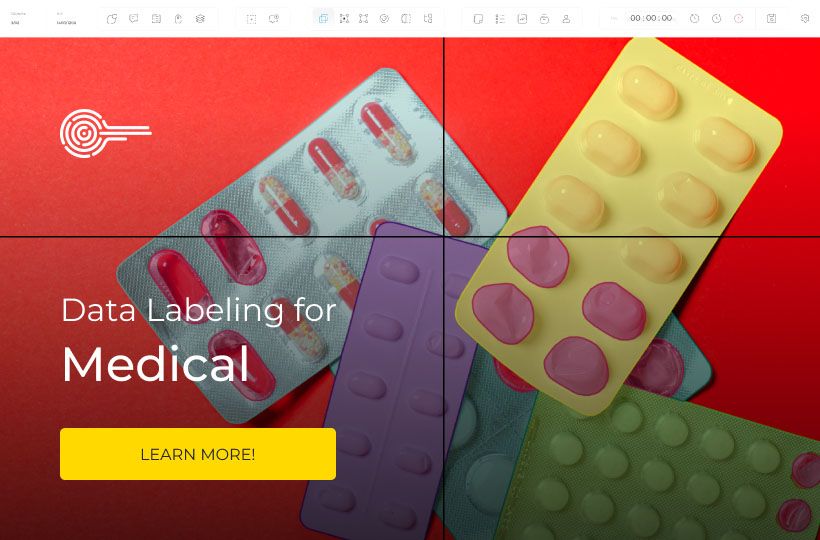Medical Data Annotation: A Guide to Medical Image Labeling
Expert-based annotations are not just functional but the foundation of modern diagnostic innovations.
Healthcare AI is now detecting tumors faster than traditional radiology methods through medical image labeling. That’s because it transforms raw scans into understandable training materials. Experts face obstacles from decoding multi-layered DICOM files to adhering to strict privacy protocols during labeling.
A single mislabeled pixel on a mammogram can change a patient’s treatment path. That’s why it’s essential to implement three-tier verification systems. Clinicians develop training protocols, execute specialized annotators, and certified physicians verify the results. This approach reduces errors compared to basic annotation methods.
Quick Take
- To achieve clinical-level accuracy, AI-based diagnostic tools require many labeled images.
- Medical imaging formats require built-in annotation tools to preserve necessary metadata.
- Three-tier quality systems prevent diagnostic errors through peer review.
- Patient privacy policies impact annotation workflows and tool selection.
- Annotation inaccuracies can lead to treatment errors across multiple continuums of care.

The Role of Medical Data Annotation in Healthcare
The accuracy of AI in healthcare depends on transforming unstructured visual information into machine-readable formats. Experts use labeling systems to convert CT scans, X-rays, and MRIs into training materials, the basis for intelligent diagnostic tools.
Structured datasets train algorithms to recognize patterns in complex images. Radiology annotation tools support the transformation of complex scans into structured clinical data for AI-based medical diagnostics. By marking tumors with bounding boxes or highlighting organ boundaries with segmentation masks, labeled materials allow systems to detect abnormalities faster than during manual review. This annotated data powers both experimental AI prototypes and FDA-approved diagnostic platforms.
Ensuring patient data privacy
Protecting sensitive information requires specialized security systems. HIPAA-compliant workflows and ISO 27001-certified platforms ensure confidentiality during labeling. Encryption protocols and access controls support privacy and enable the necessary analysis to maintain trust in AI-enabled care.
Types and methods of medical image annotation
Medical image labeling, including DICOM annotation and pathology labeling, prepares high-accuracy training data for healthcare AI systems.The main goal of this process is to train machine learning algorithms to accurately recognize pathologies, anatomical structures, and other clinically important features. High quality and accuracy of annotation are critically important, as errors can lead to false diagnoses in clinical applications or low model performance in research.
Image classification and object detection
Types of annotation include organ and tissue segmentation, lesion boundary definition, object recognition, image classification by pathological conditions, and keypoint labeling. The methods depend on the task: for complex cases, specialists manually annotate, and for routine cases, semi-automated or automatic tools are used. In addition, 3D annotations are actively used, especially for tomographic images, which allows creating more realistic spatial models of anatomical structures.
Image Segmentation and Polygonal Annotation
Segmentation methods divide visual images into precise components. Semantic methods label each pixel as a key value for tissue density analysis. Instance segmentation distinguishes multiple anomalies in individual files.
The intersection of machine learning and medical data
Modern algorithms analyze large volumes of clinical information from electronic medical records to MRI scans to automatically detect patterns, diagnose diseases, and predict risks. Machine learning has become effective in radiology, pathology, genetics, and personalized medicine, where accuracy and speed of decision-making are important. By annotating medical images, AI models receive well-defined examples of pathologies, which increases diagnostic accuracy. ML helps optimize patient recruitment, analyze treatment effectiveness, and detect side effects in clinical trials.
Three factors determine success:
- Detailed annotations that meet clinical needs.
- Diversity of cases across institutions.
- Continuous feedback to physicians.
Advances in radiology annotation directly enhance clinical decision-making by providing precise, labeled diagnostic data. All this makes machine learning an indispensable tool for the next generation of medical decisions, where the quality of data preparation directly affects patient safety and treatment effectiveness.
Medical Data Annotation Methods
Medical data annotation is the structured labeling of clinical information that provides the basis for training AI models in healthcare. The primary methods are manual annotation by experts, automated labeling using NLP algorithms, and hybrid approaches that combine human control and machine efficiency. Text data is processed using semantic analysis, entity extraction, categorization of symptoms, diagnoses, and medical procedures. For images, X-rays, MRIs, and CT scans, organ segmentation, tumor contouring, and pathological areas are used using bounding boxes or pixel marking. Video data requires frame-by-frame annotation of physician actions and tracking of instrument movements.

Medical Data Annotation Practices and Strategies
Implement a three-step validation framework to ensure clinical relevance. First, subject matter experts develop training programs using real-world case studies. Then, specialty annotators apply these recommendations. Finally, U.S.-licensed physicians review the results for diagnostic standards. Global centers allow for rapid scale-up while maintaining quality.
Balancing accuracy and efficiency in projects
Automated checks and manual reviews work together. Initial labeling is run through AI-powered tools that detect discrepancies. Human experts then refine the results, focusing on the extreme cases that require clinical evaluation. This hybrid approach achieves high accuracy in daily image processing.
Key Success Indicators:
- Error rate below 1.2% at all project stages.
- Stable throughput of 45-50 annotated studies per specialist per day.
- Weekly calibration sessions to align team interpretations.
FAQ
How does medical image annotation improve diagnostic accuracy using artificial intelligence?
Medical image annotation provides AI models with accurate examples of pathologies, allowing systems to recognize diseases better.
What security protocols protect patient information during labeling?
Medical data labeling uses encryption protocols (TLS/SSL) to protect information transmission. De-identification and access control are also used to avoid leakage of patient personal data.
What annotation methods work best for 3D medical scans?
Effective methods include voxel segmentation and 3D mask construction that accurately reflect volumetric structures. Multimodal tools with support for slice viewing (axial, sagittal, coronal) are also used for accurate labeling.
How do you ensure consistency across large annotation teams?
Clear instructions, templates, and examples for all project participants ensure consistency. Regular quality checks and feedback help avoid labeling deviations.
What are the indicators that ensure the quality of clinical-level annotations?
High accuracy and consistency between annotators ensure the quality of clinical-level annotations. Completeness and inter-expert agreement are also important indicators.
